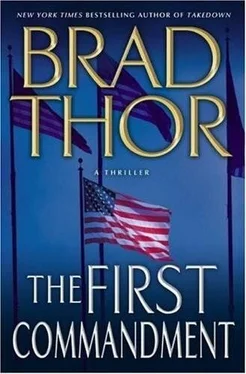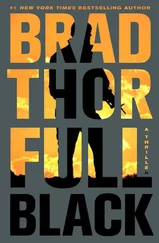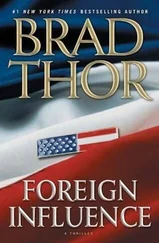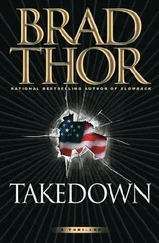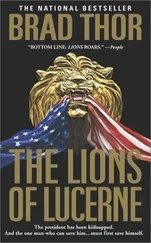Harvath felt betrayed and abandoned. The president had actually chosen the terrorists over him. It was absolutely surreal.
Be that as it might, the one thing Harvath didn’t feel was hopeless. The president could threaten him with arrest for treason, or worse, but the threats carried weight only if he got caught. And with a twenty-four-hour head start, the last thing he planned on doing was being apprehended.
Looking down at the folder he’d put on Tom Morgan’s desk, he pulled out the latest smattering of data he’d been given before leaving the conference room.
As he studied the list of aliases used by the released detainees, he came across one that he actually knew from his past, but it had belonged to a man he had killed and whom he had most definitely watched die. There was no way he could still be alive. The discovery could only mean one thing. Somebody was using his alias.
Three and a half hours later, Harvath spoke into his headset and said, “You’re positive?”
“Yes,” replied the Troll, who went over the information again. “Abdel Salam Najib is a Syrian intelligence operative who has been known to use the alias Abdel Rafiq Suleiman.”
Najib was the third name on the list, and the Suleiman alias had originally belonged to the man Harvath had killed. “What about Tammam Al-Tal?” he asked.
“Also Syrian intelligence and Najib’s handler. That’s the connection you were looking for, isn’t it?” asked the Troll.
“Maybe,” said Harvath, not wanting to give anything away to the Troll. “I want you to forward us everything you pulled on both Najib and his handler, Al-Tal.”
“I’ll send it now.”
Harvath logged off his computer, removed his headset, and turned to face his colleagues.
“You want to explain this to me?” asked Finney as he interlaced his thick fingers behind his head and stared at Harvath.
“On October 23, 1983, a yellow Mercedes Benz delivery truck packed with explosives drove out to the Beirut International Airport. The First Battalion Eighth Marines of the U. S. Second Marine Division had established their headquarters there as part of a multinational peacekeeping force sent to oversee the withdrawal of the PLO from Lebanon.
“The driver of the truck circled the parking lot just outside the Marine compound and then stepped on the gas. He plowed through the barbed wire fence on the perimeter of the parking lot, flew between two sentry posts, went through a gate, and rammed his vehicle into the lobby of the Marine HQ.”
“Why didn’t the sentries shoot this idiot?” asked Finney.
“They weren’t allowed to use live ammo,” replied Parker, who had lost a good friend that day. “The politicians were afraid an accidental discharge might kill a civilian.”
When Parker didn’t add any more, Harvath continued. “According to one Marine who survived the attack, the driver was smiling as he slammed his truck into the building.
“When he detonated his explosives the force was equivalent to over twelve thousand pounds of TNT. The rescue effort took days and was hampered by continual sniper fire. In the end, 220 Marines, eighteen Navy personnel, and three Army soldiers were killed. Sixty additional Americans were wounded. It was the highest single-day death toll for Marines since World War II and the battle of Iwo Jima. It’s also the deadliest attack on U. S. forces overseas post-World War II, but what’s most interesting from a counterterrorism viewpoint is that, kamikaze pilots notwithstanding, the attack on the Marine compound was the first real suicide bombing in history.”
Finney was speechless. He was familiar with the story, but not in such detail.
“We never knew exactly who was responsible, so aside from a few shells we lobbed at Syria, there never was any concrete response,” stated Harvath. “Now fast forward to about five years ago and a man named Asef Khashan.
“Khashan was extremely adept at guerilla warfare and the use of high explosives courtesy of training he had received from Syrian intelligence.
“He was a driving force within the Lebanon-based Hezbollah terrorist organization and reported directly to Damascus. When the United States uncovered information that Khashan had been directly involved in the planning and staging of the 1983 bombing, it was decided it was time for him to take an early retirement.”
Parker looked at Harvath from across the table and said, “And you were sent in to give him his pink slip.”
Harvath nodded.
Finney unclasped his hands and removed the pen he had tucked behind his ear. Pointing at the screen in the front of the room he said, “So this guy Najib is after you for what you did to Khashan?”
“If I’m right,” said Harvath, “then sort of.”
“What do you mean sort of? ”
“The actual connection between Najib and Khashan is via their handler, Tammam Al-Tal. Khashan was one of his best operatives. Some say that he was like a son to Al-Tal. When Khashan was killed, Al-Tal placed a bounty on my head.”
“If this was a covert operation, how’d he know you were involved?”
“We used a Syrian military officer the U. S. had on its payroll to help track down Khashan,” replied Harvath. “I never gave him my real name, but he had compiled a dossier on me with surveillance photos and other pieces of information from our meetings. When he was indicted for embezzlement not long after, he tried to use the dossier as a bargaining chip. The dossier eventually made its way to Al-Tal, who used all of his resources to connect a name to my photos. The rest is history.”
“Did Al-Tal have anything to do with the attack?” asked Parker.
“We could never uncover enough evidence to prove whether he was directly involved. There is a mounting pile of evidence, though, that Al-Tal has been helping coordinate the sell-off of the weapons of mass destruction Saddam Hussein stashed in their country shortly before we invaded.”
“How much is the bounty he put on you?”
“Somewhere around $150,000 U.S.,” answered Harvath. “Allegedly, it represents the bulk of Al-Tal’s life savings, and due to his willingness to expend said life savings to fund my demise, the powers that be in Washington removed Syria and Lebanon from my area of operations.”
“It would seem that we’ve got more than enough to believe that Al-Tal is behind the attacks on Tracy, your mom, and the ski team,” said Finney. “Do you have any idea where he is?”
“He’s undergoing treatments in Jordan for stage-four lung cancer.”
“With the end drawing near,” stated Parker, “he’s probably even more determined to take you out.”
Harvath tilted his head in response as if to say, Maybe .
“But what does Najib’s alias have to do with Al-Tal?”
Harvath looked across the table at Parker. “Abdel Rafiq Suleiman was the alias Khashan was using when I tracked him down to a Hezbollah safe house just outside Beirut.”
“So?”
“Al-Tal had given Khashan that alias.”
“It’s not uncommon for aliases to be recycled,” offered Morgan. “In some instances, a lot of time and money goes into building them. If a previous operative wasn’t too high profile, an agency or a handler might decide to pass the alias on to another operative.”
At that moment, Harvath knew exactly how he was going to take down Abdel Salam Najib.
He was going to make his handler give him up on a silver platter.
BALTIMORE, MARYLAND
Mark Sheppard had returned home with the makings of an absolute bombshell. Mac Mangan, the Charleston County SWAT team leader, had turned out to be a better resource than he ever could have imagined.
Читать дальше
